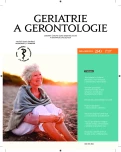Perception of the psychological dimension of quality of life by seniors with chronic non-malignant pain
Authors:
L. Pavlíčková; A. Cybulja
Published in:
Geriatrie a Gerontologie 2015, 4, č. 2: 70-73
Category:
Original Article/Study
Overview
Rating of quality of life is an ever more frequently mentioned phenomenon. The goal of our work was to evaluate chosen areas from the psychological dimension of quality of life in seniors living at social services facilities and who suffer from chronic non-malignant pain.
The prospective study was based on participative observation and objectivising proband testing using the WHOQOL-100 questionnaire. To evaluate the psychological effects of pain, the depression questionnaire according to Yesavage was used. The studied group involved 155 seniors (121 women and 34 men). Significant correlation was found between current quality of life ratings in the psychological dimension and recent occurrences of chronic non-malignant pain and depression. The most affected areas were the ability to focus (p=0.000) and feelings of sadness or depression (p=0.013). The results show that chronic non-malignant pain significantly influences how patients living in social services facilities rate the psychological dimension of their quality of life.
Keywords:
quality of life – WHOQOL-100 – elderly – social services – home for the elderly – chronic nonmalignant pain
Sources
1. Dragomirecká E, Bartoňová J. WHOQOL-BREF, WHOQOL-100: World Health Organization Quality of Life Assessment: Příručka pro uživatele české verze dotazníků kvality života Světové zdravotnické organizace. Praha: Psychiatrické centrum Praha 2006.
2. Rapey, M. Quality of Life Research: A Critical Introduction. GBR (London): SAGE Publications Ltd. 2003.
3. Gurková E. Hodnocení kvality života pro klinickou praxi a ošetřovatelský výzkum. Praha: Grada Publishing 2011.
4. Pokorná A, Eckelová I. Efektivita léčby bolesti z pohledu seniorů. Bolest 2013; 16(2): 77– 82.
5. Ondrušová J, Dragomirecká E. Smysl života a deprese u českých seniorů. Československá psychologie 2012; 3: 193–205.
6. Raudenská J. Psychologie chronické bolesti ve stomatologii. Stoma team 2011; 11(5): 81–85.
7. Roth J, Preiss M, Uhrová T. Deprese v neurologické praxi. Část první: symptomy, diagnostika, rizikové faktory. Praha: Galén 1999.
8. Pidrman V. Poruchy nálady u seniorů: příručka pro pacienty a jejich rodiny. Praha: Maxdorf 2010.
9. Holmerová I, Vaňková H. Demence a deprese ve vyšším věku. Medicína pro praxi 2009; 6(2): 111–114.
10. Laňková J, Raboch J. Deprese: Doporučené diagnostické a terapeutické postupy pro všeobecné praktické lékaře. Společnost všeobecného lékařství ČLS JEP: Centrum doporučených postupů pro praktické lékaře, 2013.
11. Drástová H, Krombolz R. Deprese v séniu. Med praxi 2006; 3(5): 241–243.
12. Franková V. Depresivní poruchy ve stáří. Postgrad med 2010; 12(6): 634–642.
13. Gillernová I, Kebza M, Rymeš M a kol. Psychologické aspekty změn v české společnosti: Člověk na přelomu tisíciletí. Praha: Grada Publishing 2011.
14. Lužný J. Hodnocení bolesti u klientů se středně těžkou a těžkou demencí. Oše por asistence 2013; 4(4): 678–683.
15. Vágnerová M. Vývojová psychologie II. Dospělost a stáří. Praha: Karolinum 2007.
Labels
Geriatrics General practitioner for adults Orthopaedic prostheticsArticle was published in
Geriatrics and Gerontology

2015 Issue 2
- Memantine Eases Daily Life for Patients and Caregivers
- Metamizole at a Glance and in Practice – Effective Non-Opioid Analgesic for All Ages
- Advances in the Treatment of Myasthenia Gravis on the Horizon
- Memantine in Dementia Therapy – Current Findings and Possible Future Applications
- Metamizole vs. Tramadol in Postoperative Analgesia
Most read in this issue
- Chronic pancreatitis in the old age
- Nutritional support in dementia patiens
- Chronic heart failure – specifics of treating seniors
- Chest pain in a patient with thoracic aorta dissection
